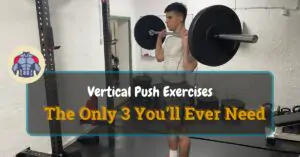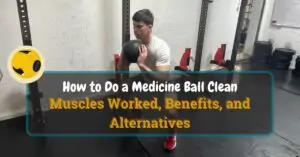I must say I got quite annoyed when I realized that most fitness enthusiasts, especially a big portion of the online fitness creators population, don’t have a clue what a vertical push exercise actually is.
Table of Contents
ToggleI keep seeing landmine presses and lateral raises all over different fitness articles, and that’s no bueno.
Why?
Because the landmine press follows a diagonal movement pattern, it’s neither a horizontal nor a vertical push exercise.
Lateral raises involve simple shoulder abductions. If you know anything about the principles of functional training and planes of motion, you should probably know that for a push movement to occur, you must have some type of elbow extension, which isn’t present during lateral raises.
To make things even worse, I keep seeing so many unnecessary vertical push exercise variations no one needs to perform to build muscle and strength. So, to make sure you get the best bang for your buck and actually perform the exercises that will make the difference, I created a list of 3 simple exercises.
These are all the vertical push exercises you need to build functional strength, stabilizer strength, muscle hypertrophy, and even some endurance with the machine shoulder press variation towards the end of the list.
Start Building Your Dream Body Today
Ready to elevate your fitness game without falling into the trap of dull, repetitive routines that just don’t deliver? Imagine sculpting your ideal physique and boosting your health, all while still enjoying life’s pleasures, like those irresistible weekend getaways and your aunt’s legendary cheesecake. With our online fitness and nutrition coaching service, you don’t have to compromise. Dive into a personalized fitness journey that blends perfectly with your lifestyle, not against it. Book your completely free discovery consultation today, and take the first step towards a transformation that doesn’t require giving up the joys of life.

“I was skeptical about online fitness coaching, but Functional Body Savage completely changed my perspective. Vanja and Radomir’s personalized approach and attention to detail have helped me achieve goals I never thought possible. I’m stronger, more confident, and grateful for their guidance.”
Emily Thompson, San Francisco, CA
Learn More About Our Online Coaching ServiceQuick Summary
- The only three vertical push exercises you will ever need are the barbell overhead press, seated dumbbell press, and machine shoulder press.
- These exercises are chosen for their effectiveness in building functional strength, muscle hypertrophy, and stabilizer strength, with variations to accommodate fatigue and CNS demands.
- A study cited on PubMed emphasizes that barbell overhead presses activate muscles more significantly than machine presses, underscoring the importance of incorporating free weights for optimal muscle engagement.
- In my experience, properly programming your push workouts is simple, but most people fail because of a lack of discipline and controlled exercise diversity, which is why we launched our online health and fitness coaching service to help.
3 Best Vertical Push Exercises to Build Muscle and Strength
Now, I will first explain the rationale for these three exercises and why I listed them in this specific order. First, I choose the barbell overhead press because it is a big compound movement that will build tremendous upper body strength.
And not just any, but it will build real-world functional strength. This is because it activates a lot of stabilizer muscles during the movement while also being performed from an athletic standing position. A study found on PubMed suggests that an overhead press performed using a barbell excites muscles more than using a machine to stabilize the trajectory of the external load [1].
Then, we proceed to the seated dumbbell press. I like seated dumbbell presses because they aren’t as taxing for our central nervous system as the standing variation is. Also, they introduce another layer of instability, similar to the barbell variation, but even more, because we need to synchronize both arms simultaneously.
Lastly, I finish with the machine shoulder press because your CNS is already fatigued towards the end of the workout, and you have less energy (adenosine triphosphate) at your disposal.
I know that the machine shoulder press isn’t the most functional exercise in the world, but that’s why we come here from the functional bodybuilding approach and incorporate some easier movements towards the end of a workout, just to get that much more from our exercise session.
Let’s jump into the exercises now and how to perform them correctly.
Military Press (Also Called the Barbell Overhead Press)
Here is a very important thing to remember when doing military presses:
If you don’t scream on the last two or three reps from the sheer pain in your shoulders and triceps, don’t do the exercise.
There is no point, and you are a lost cause. Just kidding, here is how to do the exercise properly without getting injured.
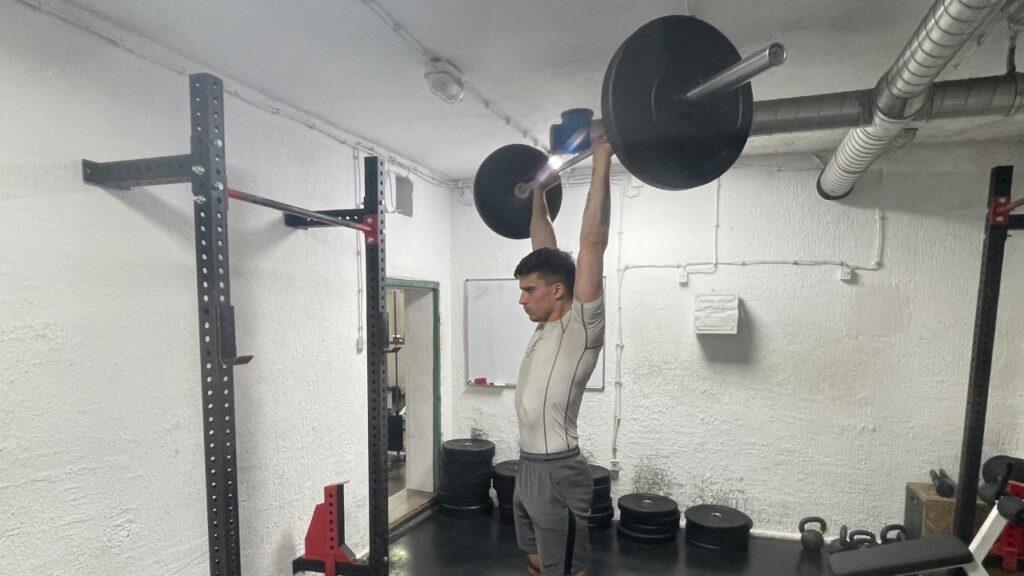
Steps:
- Rack the barbell and load it with the appropriate weight.
- Grasp the barbell with your hands just outside your shoulders or a little narrow, depending on your personal preference and unique morphology.
- Assume the front rack position with your arms and hold the barbell on your upper arm portion just as if you are doing front squats.
- Unrack the barbell, take a step back, and assume a shoulder-width-apart athletic stance with your feet and knees slightly bent.
- Push the barbell over your head by abducting your shoulders and extending your elbows simultaneously.
- Lock your elbows at the top and make sure your entire abdominal wall and hip muscles are isometrically contracted to ensure proper balance.
- Slowly return the barbell to the starting position and repeat the whole thing again for the desired amount of reps.
Pro Tip: When pushing the barbell upwards towards the ceiling, make sure to bring it right above the level of your head. Most people leave the barbell slightly forward, which causes different instability issues and sometimes even leads to injuries.
Seated Dumbbell Press
I love seated dumbbell presses because they allow you to focus on developing your shoulders and vertical pushing strength while sitting but still require substantial activation of your stabilizer muscles. This is what makes them both functional and excellent for muscle-building purposes.

Steps:
- Pick two dumbbells of appropriate weight so you can perform between 6 and 12 reps.
- Ensure you set up an incline to 90 degrees so you have adequate support for your back during the exercise.
- Sit on the bench, ensure a firm grip on the ground with your feet, and keep your back neutral.
- Place both dumbbells in the overhead position with your elbows fully extended.
- Start the exercise by lowering the dumbbell until the angle between your torso and upper arm and the angle between your upper arm and forearm is exactly 90 degrees.
- Hold the bottom position for one second.
- Extend your elbows and push both dumbbells to the starting overhead position.
- Repeat for the desired amount of reps.
Pro Tip: Feel free to experiment with the depth during the lowering phase. Some individuals prefer going deeper than 90 degrees because it yields better muscle hypertrophy and strength effects.
Machine Shoulder Press
The machine shoulder press is the last exercise on the list because it requires the least amount of energy and central nervous system freshness to be performed. This is also why we put it towards the end of the vertical push workout.
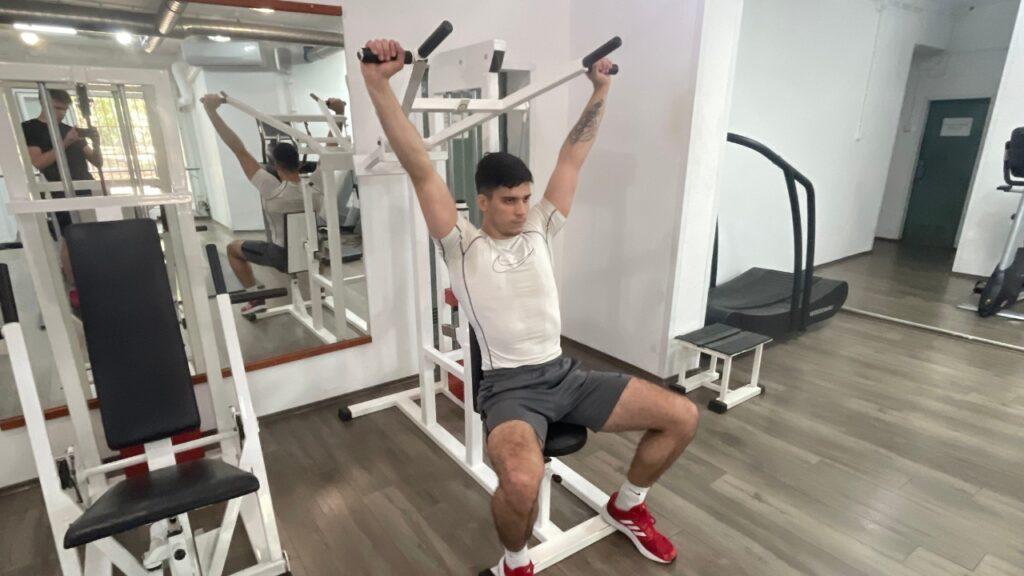
Steps:
- Set the appropriate weight on the shoulder press machine so you can perform between 8 and 12 reps.
- Assume the sitting position and grab the handles of the machine.
- Start the exercise by pushing both handles towards the ceiling and stop when your elbows are fully extended.
- Now lower the handles to the starting position and hold the bottom position for one second.
- Repeat for the desired amount of repetitions.
Pro Tip: Go heavy on this machine shoulder press variation since it isn’t as demanding as the previous two exercises. Focus primarily on proper muscle contraction and feeling the muscle all the way up and down as you move the handles. Intensity is key with this last machine press variation.
Expert Discusses the Perfect Warm-up for the Push Workout
In a YouTube Video, Jeff Nippard, a professional bodybuilder and powerlifter, discusses the best way to warm up for push workouts.
“As usual, we are kicking things off with a five-minute general warm-up on the treadmill. Then we are doing a few quick dynamic stretches like arm swings and cable external rotations. From there, we are jumping into three sets of 8, then 5, and then 15 reps on the close grip barbell incline bench press. This is a unique undulating set pattern where the first working set uses more moderate weight for eaight reps. The second set uses heavier weights for five reps and then the third sets uses a lighter weight for 15 reps. Of course to get to those working sets you’ll do a few quick warm-up sets first. After those warm-up sets, you can proceed with the first working set.”
Supplementary Exercises for Developing Broader and More Functional Shoulders
Now, although the previous three exercises are almost everything you need to build functional upper-body pushing strength, there are some supplementary exercises you can still incorporate to maximize the overall effectiveness of your workout.
Let’s quickly glance over them below.
Modified Lateral Raises
The modified lateral raise will ensure better deltoid hypertrophy.
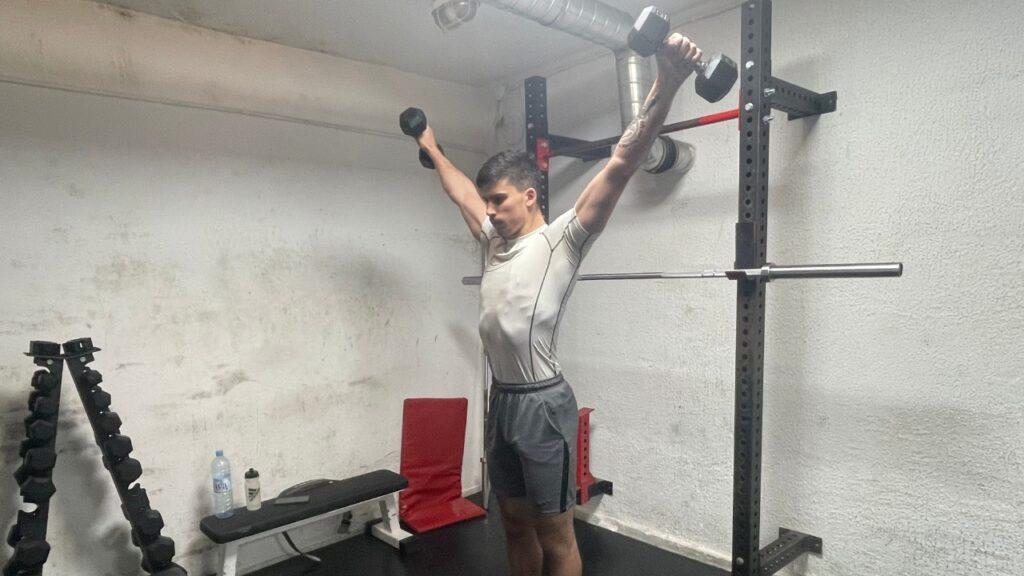
Steps:
- Pick two dumbbells of appropriate weight and assume a standing starting position with your feet hip-width apart.
- Ensure your knees are extended, your back flat, and your eyes are looking straight ahead.
- Contract your ab and hip muscles to ensure better stability during the exercise.
- Hold both dumbbells on the sides of your body with your elbows almost fully extended.
- Start the exercise by abducting your shoulders and lifting the dumbbells towards the level of your shoulders.
- Pass the horizontal line connecting your shoulders and raise the dumbbell up towards the ceiling for another 30 degrees.
- You will essentially form a letter Y.
- Hold the top position for one second and reverse the motion by lowering the dumbbells and adducting your shoulders to return to the starting position.
Pro Tip: Try avoiding compensatory movements from other parts of your body. It is easier to lift both dumbbells by including hip bending and extension or similar quick hacks that allow you to lift more weights but don’t build more muscles.
Handstand Push-Ups
The handstand push-up is the ultimate test of your vertical pushing strength. Not only is it hard to lift your entire body weight, but you also must stabilize all other parts of your body during this hard movement.
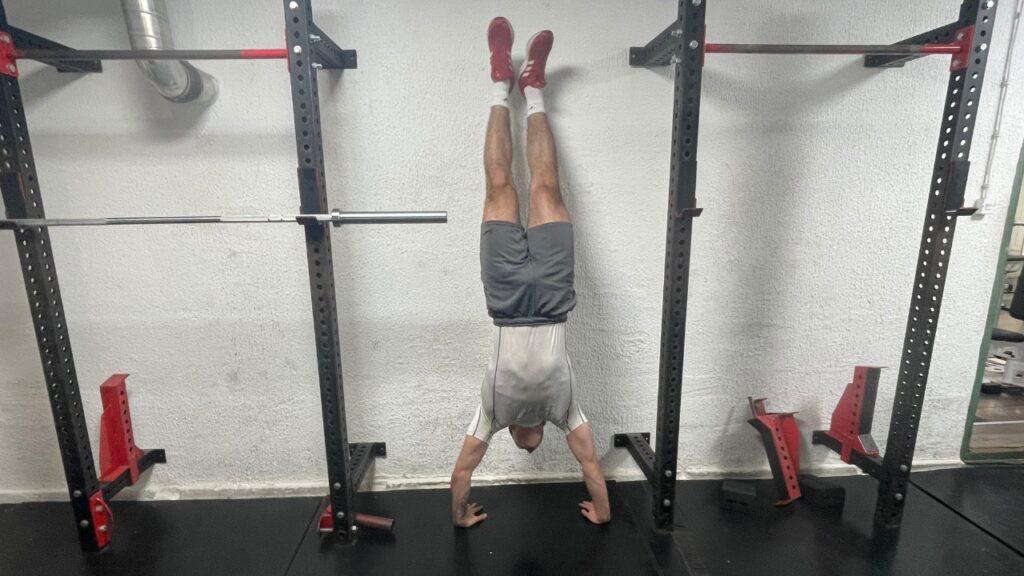
Steps:
- Perform a handstand against the wall and ensure your elbows are extended while your head is in a neutral position.
- Lower your body towards the floor by bending your elbows and adducting the shoulders.
- When your head is just about to reach the ground, reverse the motion and return to the starting position.
- Ensure your core is contracted during the entire exercise for added stability and overall safety from injuries.
Pro Tip: Ask a friend to help you pull your legs slightly up during the second phase of the exercise. Handstand push-ups are extremely demanding, and you will need some help in the beginning if you can’t perform a full range of motion on your own.
FAQs
What Muscles Do Vertical Push Exercises Target?
Vertical push exercises primarily target the deltoid muscles in the shoulders, the triceps in the upper arms, and the upper pectoral muscles in the chest. Vertical pushing exercises engage these muscles by pushing weight vertically overhead, and they can include movements like standing barbell presses and seated dumbbell presses.
Is Vertical Pressing Necessary?
Vertical pressing is not strictly necessary for everyone, but it is beneficial for those looking to build strength and muscle in the upper body, particularly in the shoulders and arms. Including vertical pressing in a workout regimen helps ensure a balanced strength training program that covers all major muscle groups.
What Are the Benefits of Vertical Push Exercises?
The benefits of vertical push exercises include improved muscular strength and endurance in the upper body, particularly in the shoulders, arms, and chest. These exercises also enhance overall shoulder stability and can contribute to better posture and functional daily movements.
A Better Approach to Upper Body Functional Strength and Hypertrophy
Building upper body strength and muscle isn’t easy, but it’s quite simple.
However, this is only assuming you are already familiar with the core principles of functional strength training and how muscles actually grow.
And let’s be honest; nobody really wants to learn all these unnecessary scientific methods, all while having a full-time job, 2 kids, and free time to enjoy the hobbies and activities that allow you to recover and be normal in this crazy, fast-paced world.
That’s why we started an online fitness and nutrition coaching service: so people can focus on the most important things in their lives while simultaneously allowing us to help them with their health and fitness goals.
If you believe you would benefit from such a service, feel free to schedule a free consultation call with our team.
I promise you will never regret starting to work on your health, strength, fitness, and overall confidence in your physical appearance.
Start Building Your Dream Body Today
Ready to elevate your fitness game without falling into the trap of dull, repetitive routines that just don’t deliver? Imagine sculpting your ideal physique and boosting your health, all while still enjoying life’s pleasures, like those irresistible weekend getaways and your aunt’s legendary cheesecake. With our online fitness and nutrition coaching service, you don’t have to compromise. Dive into a personalized fitness journey that blends perfectly with your lifestyle, not against it. Book your completely free discovery consultation today, and take the first step towards a transformation that doesn’t require giving up the joys of life.

“I was skeptical about online fitness coaching, but Functional Body Savage completely changed my perspective. Vanja and Radomir’s personalized approach and attention to detail have helped me achieve goals I never thought possible. I’m stronger, more confident, and grateful for their guidance.”
Emily Thompson, San Francisco, CA
Learn More About Our Online Coaching ServiceReferences:
- Coratella G, Tornatore G, Longo S, Esposito F, Cè E. Front vs Back and Barbell vs Machine Overhead Press: An Electromyographic Analysis and Implications For Resistance Training. Front Physiol. 2022;13:825880. Published 2022 Jul 22. doi:10.3389/fphys.2022.825880


